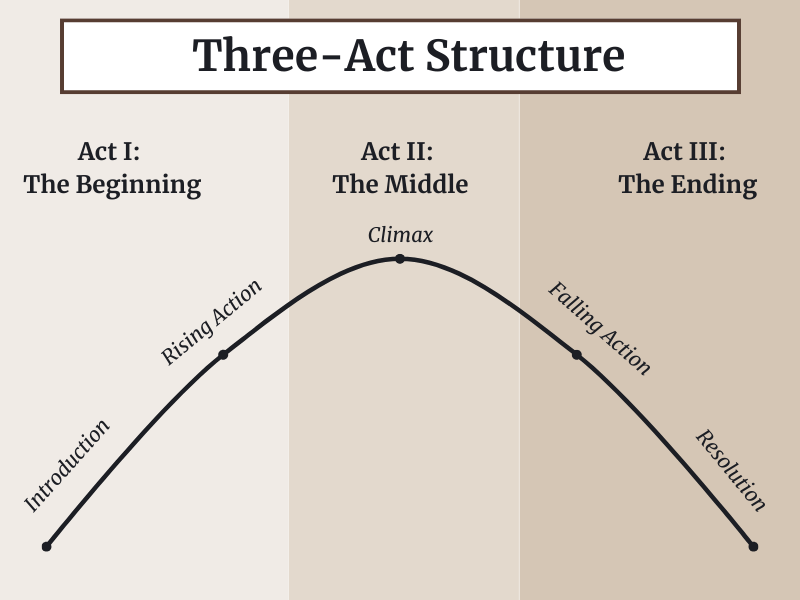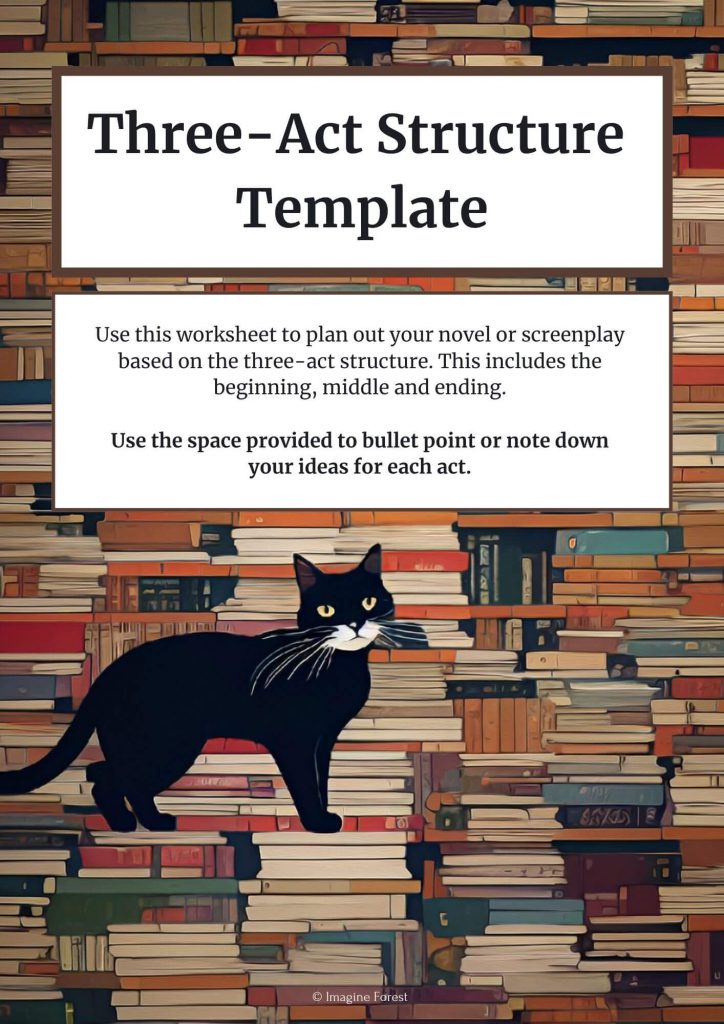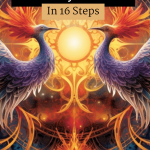Three-Act Structure With Examples (+ Free Template)
The three-act story structure is a method of organising a novel. It is useful because it allows you to write a book in manageable chunks, and also provides a roadmap on how to structure your story. In this post, we’ll explain the three-act structure for novels, along with some famous examples to illustrate each of the elements. There’s also a free three-act structure template available at the end for you to use.
What Is The Three-Act Structure?
The three-act structure is a popular way of structuring novels. Just like many other methods of outlining a novel, the three-act structure is flexible and can be altered to fit almost any kind of story. This structure is based on Aristotle’s model of tragedy, where the three acts of a play are:
- Exposition: The setup of the conflict and the introduction of characters and setting.
- Climax: The climax is when the protagonist faces their biggest challenge, and the stakes are raised.
- Resolution: The resolution is the end of the story. It might be a moment of victory for the protagonist or it might be a defeat.
In simpler terms, you can see this as the beginning, middle and end of a story. You may recognise some of these elements from other structures, such as the story mountain.

The three-act structure is widely used for screenplays, films, TV shows and novels. And can be applied to a range of genres including everything from drama and romance to action and adventure. Interestingly, the three-act structure can also be applied in non-fiction works, such as presentations, documentaries, newspaper articles and even in speech writing.
Benefits of the Three-Act Story Structure
The three-act structure provides writers with a lot of benefits. Let’s take a look at some of the main ones.:
- Easily divides a novel into smaller parts: When we were children, we learned that stories should have an introduction, a conflict, and a resolution. These are all key elements of a strong plot. You could easily write a story with these elements by following the three-act structure.
- It provides writers with a clear path to the end: A common problem for many writers is knowing how to end their story. This problem can be avoided if you use the three-act structure. You will know exactly how long your story should be and what it should include.
- Provides writers with a guide for creating the perfect opening and ending: There’s nothing worse than writing a beautiful first sentence or last sentence only to have the rest of the novel be a big mess. It’s much better to plan out your novel and write the perfect opening and closing lines first. Then you can use them as templates for the rest of the book.
- Helps writers know when to cut out parts of their novel: If you’re using the three-act structure, you’ll know when to cut out parts of your novel because you’ve already divided the story into smaller sections. For example, if you have two major points of conflict in your novel, and they happen at the end of Act 1 and the beginning of Act 2, then you can safely assume that you don’t need to include them again until the very end of the book.
- Helps keep a story interesting: Another benefit of the three-act structure is that it helps writers keep their stories interesting. Think about it. What’s more interesting than watching a character go through a difficult time? When you know what to expect, you’ll be more interested in what happens next.
If you have a clear idea of the beginning, middle and end of your story, then writing the chapters and scenes will be much easier. Plus, you also end up with an amazing, thought-out ending that will make your audience want more.
The 3-Act Structure Explained
Just like in the name, the three-act structure has 3 parts to do it, each part has been explained below with examples:
The Beginning
The beginning can also be known as the set-up or exposition. Here you have to establish the main characters, the setting and the start of a conflict. This is the most important part of the story because it’s what hooks your reader in. The best way to do this is to start with a conflict or problem that will drive the action throughout the rest of the story.
For example, a boy named Fred was always getting bullied by his classmates for being the “dumbest kid in school.” One day, he accidentally breaks into the principal’s office and finds out that the principal has been stealing money from the school’s budget. He confronts the principal and reports him to the police. But no one believes him and Fred is expelled from his school.
The Middle
This can also be known as the confrontation or climax of the story. Here your main character or protagonist has to deal with the conflict and try to solve the problem. The events are not always linear, and they don’t always happen in order, but there needs to be some kind of change in the middle of the story.
For example, Fred is forced to transfer to a different school after getting kicked out of his old one. His new school is much nicer and has better facilities than the last one, but it doesn’t make things any easier for Fred. He’s still getting bullied by his new classmates, and now he also has to deal with being the new kid at school.
The Ending
The ending is sometimes known as the resolution since this is where the conflict is solved. It’s also where everything comes together and we learn how it all ends. It can be happy or sad, but there needs to be a feeling of satisfaction or completion.
For example, Fred finally stands up for himself and tells his bully to stop picking on him. This makes his classmates respect him more and the bully realises that he was being a jerk and apologises. Fred now files like a new person and is ready to start a new chapter in his life.
To help you better understand the three-act story structure, we have included a couple of famous examples in the section below.
Best Examples of the Three-Act Structure
The three-act structure is used in a lot of stories, but it is especially helpful for screenplays and novels because it allows the writer to think about the story from the beginning to the end. Here are some examples of films and novels that use this structure.
Wizard Of Oz: Film by Victor Fleming (Adaption of L. Frank Baum’s Book)
In the first act of “The Wizard of Oz,” we’re introduced to the main character, Dorothy Gale, who lives on a farm in Kansas with her Aunt Em and Uncle Henry. She is swept away to the Land of Oz by a tornado and discovers that she is not in Kansas anymore. Dorothy’s central conflict is to find a way back home, but she doesn’t know how. She sets out on a journey to find the Wizard of Oz, who is said to have the power to send her back home.
In the second act, Dorothy meets three companions on her journey to the Wizard of Oz: the Scarecrow, the Tin Man, and the Cowardly Lion. Each of them has a specific goal that they hope the Wizard of Oz will help them achieve. However, they face obstacles such as the Wicked Witch of the West and her minions, who want to stop them from reaching the Wizard. The second act builds tension and leads to a climactic moment where Dorothy and her companions finally meet the Wizard, who promises to grant their wishes if they bring him the broomstick of the Wicked Witch.
In the third act, Dorothy and her companions confront the Wicked Witch of the West, who tries to stop them from completing their mission. They manage to obtain the broomstick, but the Witch sets fire to the Scarecrow in retaliation. In a climactic moment, Dorothy throws a bucket of water on the Witch, causing her to melt away. With the Witch defeated, Dorothy and her companions return to the Wizard, who reveals that he is not actually a powerful wizard, but a regular man. However, he grants their wishes anyway, and Dorothy is able to return home to Kansas.
Harry Potter and the Philosopher’s Stone by J.K. Rowling
In the first act of “Harry Potter and the Philosopher’s Stone,” we’re introduced to the protagonist, Harry Potter, and his ordinary world. We learn that he’s been living with his cruel and neglectful relatives, the Dursleys and that he’s never known his true identity as a wizard. One day, he receives a letter inviting him to attend Hogwarts School of Witchcraft and Wizardry, and his life is changed forever. This sets up the central conflict of the story: Harry’s struggle to come to terms with his magical abilities and his battle against the dark wizard, Voldemort.
In the second act, Harry attends Hogwarts and faces a series of challenges and obstacles. He makes friends with Ron Weasley and Hermione Granger, and together they investigate the mystery of the Philosopher’s Stone, a powerful object that Voldemort is seeking. Along the way, they face challenges such as the troll in the dungeon, the Forbidden Forest, and a life-sized game of wizard’s chess. This builds up tension and leads to a climactic moment where Harry and his friends face off against Voldemort and his followers to prevent them from obtaining the Philosopher’s Stone.
In the third act, Harry and his friends successfully defeat Voldemort and prevent him from obtaining the Philosopher’s Stone. Harry learns that the key to his victory was his ability to love and protect his friends, and he is rewarded for his bravery and selflessness. The story ends with Harry returning to the Dursleys for the summer, but with the promise of more adventures to come at Hogwarts.
You might also be interested in this list of Harry Potter writing prompts.
The Hunger Games by Suzanne Collins
In the first act of “The Hunger Games,” we’re introduced to the protagonist, Katniss Everdeen, and the world she lives in. We learn that she lives in District 12, one of the poorest and most neglected districts in the country of Panem. She’s a skilled hunter and provider for her family, and she has a close relationship with her younger sister, Prim. When Prim is chosen as a tribute in the Hunger Games, a brutal annual competition where teenagers from each district fight to the death, Katniss volunteers to take her place. This sets up the central conflict of the story: Katniss’s struggle to survive the Hunger Games and overthrow the corrupt government of Panem.
In the second act, Katniss competes in the Hunger Games and faces a series of challenges and obstacles. She allies with Peeta, a fellow tribute from District 12, and together they navigate the dangerous arena and form a strategy to stay alive. Along the way, they face challenges such as the vicious Career tributes, the muttations, and a deadly firestorm. This builds up tension and leads to a climactic moment where Katniss and Peeta are the only two remaining tributes, and the Capitol changes the rules to force them to fight each other.
In the third act, Katniss and Peeta refuse to fight each other and instead threaten to commit suicide, forcing the Capitol to declare them both winners of the Hunger Games. This act of rebellion inspires the people of Panem to rise up against their government and leads to a revolution. Katniss becomes a symbol of hope and resistance, and she sets out to lead the rebellion against the Capitol. The story ends with Katniss and Peeta returning to District 12, but with the knowledge that their fight for freedom is far from over.
The Fault in Our Stars by John Green
In the first act of “The Fault in Our Stars,” we’re introduced to the protagonist, Hazel Grace Lancaster. We learn that she’s a teenager living with a terminal illness that requires her to carry an oxygen tank with her everywhere she goes. Hazel is lonely and feels like she’s a burden on her parents. She meets Augustus Waters at a cancer support group, and they form a connection based on their shared experiences of living with illness. This sets up the central conflict of the story: Hazel’s struggle to find meaning in her life despite her illness and the inevitability of death.
In the second act, Hazel and Augustus fall in love and embark on a journey to meet Hazel’s favourite author, Peter Van Houten, who lives in Amsterdam. Along the way, they face obstacles such as Augustus’s relapse and the disappointment of meeting Van Houten, who turns out to be a bitter and disillusioned man. This builds up tension and leads to a climactic moment where Augustus reveals that his cancer has returned and is now terminal.
In the third act, Hazel and Augustus struggle to come to terms with the fact that their time together is limited. Augustus’s health deteriorates rapidly, and he dies in the end, leaving Hazel to cope with her grief and loss. However, in his death, Augustus inspires Hazel to live a full life and to embrace the time she has left. The story ends with Hazel understanding that life is not a “book” that needs to have a certain structure or ending, but rather a journey to be lived to the fullest.
Free Template
Now you know everything you need to about the three-act structure for novels and screenplays. You can use this free three-act structure template to plot out your next big story:

This template is very easy to use, just simply add in your notes about your story for each act of the 3 act story structure. Once completed you will have an organised structure for your story that considers all three elements of the three-act story structure model.
Thank you for reading this post. let us know in the comments if you find this guide on the three-act structure useful.






Comments loading...